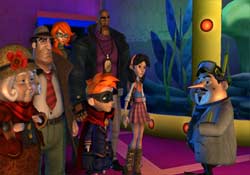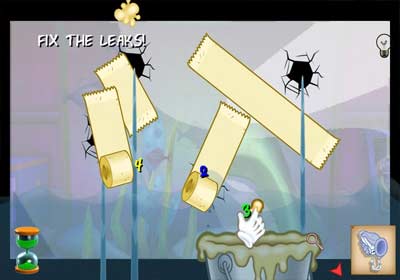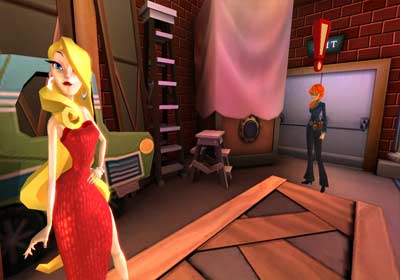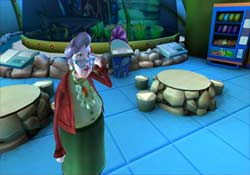Whether it is in a movie, televisions show, book, or a game, I’ve always found a good mystery to be enjoyable. Trying to be observant, picking up on subtle clues, compiling information, and ultimately, figuring out who or what is responsible. However, I’m not saying all mysteries should be serious, as the over-the-top movie Clue is easily one of my all-time favorites. This is the side of whodunits that Guilty Party falls into, not taking itself too seriously but still managing to keep the players attention from start to finish with its charm.

The story of Guilty Party revolves around the family owned and operated Dickens Detective Agency. The family of sleuths that make up the agency are an eccentric and varied bunch. On one hand, you’ve got characters like Max, an overweight detective who seems like a somewhat realistic portrayal of a real person, and on the other, you have over-the-top characters such as Kid Riddle, a child always wearing a cape and mask, and Charlotte, a senior citizen who loves to perform martial arts on evildoers. Luckily, since the game doesn’t take itself seriously, all of these characters fit in perfectly and generate some genuinely humorous dialog and antics during their quest to hunt down the agency’s nemesis, Mr. Valentine.
Guilty Party’s story mode is what helps to separate the game from the plethora of other party games that have continued to flood the Wii since its release. This mode consists of six levels, a prologue, and a finale, each bookended with humorous cinematics that keep the story moving forward. The prologue does a good job of introducing the player to the concepts they will need to progress through the game and take down Mr. Valentine. These include moving, questioning suspects, collecting clues, narrowing down your suspects (by discovering the criminal’s height, shape, hair style, and gender), and pudding, which manages to play a large role throughout, even if not in the gameplay.
The game plays out similarly to many board games, having players taking turns moving around what is essentially a board while trying to get to the bottom of each level’s mystery. Each turn has the player receiving three coins and picking a savvy card at random from three possible choices. Coins are used to move your character any number of rooms by choosing your destination and then paying a coin to move there. They are also needed in order to interrogate witnesses and collect clues, at the cost of one coin apiece. Either way, paying your coin will instigate a mini-game in which you must perform one of over forty random tasks in order to uncover what you’re looking for.

Most of the mini-games involve things related to investigation, such as bribing a witness, dusting for prints, and piecing together shredded clues. However, there are also mini-games that appear completely unrelated, such as picking a person’s favorite food, swatting bugs, and patching leaking holes with glue and tape. Even so, the sheer variety of mini-games helps to keep any of them from getting stale. While you may not see the point in one of the mini-games you are tasked with, at least you’re not just repeatedly doing the same ten that make sense.
The mini-games in Guilty Party can be humorous, but from a gameplay perspective, they aren’t always exactly fun or challenging. Almost every mini-game in Guilty Party can be solved by shaking the Wii-Remote erratically, pointing it at the screen, dragging objects, or a combination of the three. This makes completing these tasks almost an afterthought and an inconvenience. However, things get even worse as the game decides that you need to jump up in difficulty.

Rather than giving the player the option of making the game harder or easier, your difficulty level is set depending on how you perform in mini-games. If you do too well, the game will inform you things are going to get harder, giving you no choice in the matter. While this isn’t a terrible idea on paper, some of the mini-games are ridiculously unbalanced when played at higher levels. For instance, one mini-game tasks you with shaking the Wii-Remote in order to use a fan to clear the fog away from a witness’s memory. On the easiest difficulty level, there is one memory and it can be cleared in about five seconds. However, on the hardest difficulty, there are three memories which continue to fog back over when not being fanned, making clearing all three in the time allotted insanely difficult. I’m not necessarily opposed to a challenge, but when you can breeze through several mini-games without much effort only to get stuck on one in particular for several turns’ worth of coins, something is wrong.
Savvy cards also play a part in the action, giving players added bonuses that help solve the mystery. These can provide anything from additional coins to being able to move around the current environment for free as long as you still have one coin left. These cards will also be necessary for undoing the negative influences of Mr. Valentine, who will attempt to impede the players’ progress after every turn. A card may allow you to turn the lights back on in a room, allowing you to see witnesses and clues that would otherwise be hidden or even unlock doors that would stop the course of your investigation if left locked.

However, when playing in the game’s other mode, Party Mode, savvy cards take on a life of their own. While you can play cooperatively in Party Mode, some may find competitive play more entertaining. When playing against up to three other players, it is as important to slow down the other players as it is to solve the mystery. Savvy cards will make this much easier, allowing each player to sabotage others by locking doors around them, taking their coins and cards, turning out the lights, or simply moving them away from clues. Unfortunately, when playing with four players, most mysteries remain unsolved due to the sheer amount of mayhem unleashed by the players, while competing with fewer players seems less interesting and more mean spirited, as there are fewer players to pick on.
Still, the Party Mode can be a fun alternative to the Story Mode, as it will provide most of the game’s replay value. Once you’ve played through the Story Mode, that’s it, you’ve experienced the game’s story and it will play out the exact same way every time (even the witness’s testimonies and clues). However, in the Party Mode, while you won’t be treated to the humorous cutscenes before and after every case, the mysteries are randomized. After playing through a plethora of matches in this mode, I didn’t have one case that played out similarly to another, other than the basic formula of the game which remains constant no matter the mode or case.
If you’re looking for a family friendly whodunit game, Guilty Party is likely your only alternative. Fortunately, it is a good one with its zany characters, humorous antics, ridiculous story, and easy to get into gameplay. However, if you’re looking for good gameplay, you may find the included mini-games to be a letdown, as most aren’t exactly fun or particularly challenging. In the end, although Guilty Party could simply be labeled as just another mini-game compilation, its charm, humor, and story make it feel significantly more substantial than the plethora of soulless “fifty games in one” titles that continue to crowd store shelves.
RATING OUT OF 5 RATING DESCRIPTION 3.8 Graphics
The characters are quite expressive, although, when viewed close up, some can be a little creepy. 3.2 Control
Most of the mini-games simply require waggling to complete, however, when precision is needed, there can be issues. 4.1 Music / Sound FX / Voice Acting
The music and sound effects fit the game perfectly, with a custom theme song for the title thrown in for good measure. Unfortunately, the characters’ in-game dialog does get repetitive quickly. 3.7
Play Value
The Story Mode is the real highlight of this package, while the Party Mode helps to add longevity to the title after you’ve solved the main mystery.
3.7 Overall Rating – Good
Not an average. See Rating legend above for a final score breakdown.
Game Features:
